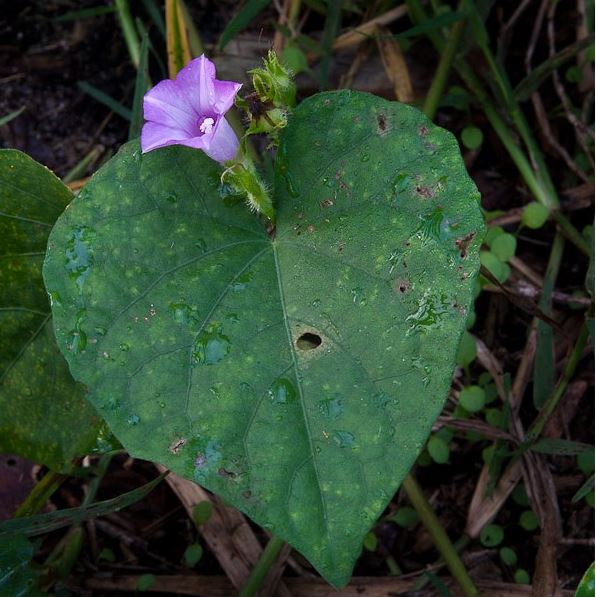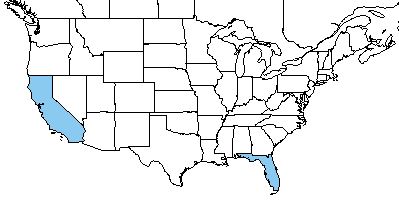Difference between revisions of "Ipomoea triloba"
(→Conservation and Management) |
HaleighJoM (talk | contribs) (→Ecology) |
||
| (9 intermediate revisions by 4 users not shown) | |||
| Line 1: | Line 1: | ||
{{italic title}} | {{italic title}} | ||
| + | Common name: Little-bell<ref name="weakley">Weakley, A.S. 2015. Flora of the southern and mid-atlantic states. Working Draft of 21 May 2015. University of North Carolina at Chapel Hill, Chapel Hill, North Carolina.</ref> | ||
<!-- Get the taxonomy information from the NRCS Plants database --> | <!-- Get the taxonomy information from the NRCS Plants database --> | ||
{{taxobox | {{taxobox | ||
| Line 18: | Line 19: | ||
}} | }} | ||
==Taxonomic Notes== | ==Taxonomic Notes== | ||
| − | Synonyms: none. | + | Synonyms: none.<ref name="weakley">Weakley, A.S. 2015. Flora of the southern and mid-atlantic states. Working Draft of 21 May 2015. University of North Carolina at Chapel Hill, Chapel Hill, North Carolina.</ref> |
| − | Varieties: none. | + | Varieties: none.<ref name="weakley">Weakley, A.S. 2015. Flora of the southern and mid-atlantic states. Working Draft of 21 May 2015. University of North Carolina at Chapel Hill, Chapel Hill, North Carolina.</ref> |
==Description== | ==Description== | ||
<!-- Basic life history facts such as annual/perrenial, monoecious/dioecious, root morphology, seed type, etc. --> | <!-- Basic life history facts such as annual/perrenial, monoecious/dioecious, root morphology, seed type, etc. --> | ||
| − | ''I. triloba'' is a perennial forb or vine. It belongs to the Covolvulaceae family. This species is not native to the continental United States <ref name="USDA"> USDA Plants Database URL: https://plants.usda.gov/core/profile?symbol=IPTR2 </ref> | + | ''I. triloba'' is a perennial forb or vine. It belongs to the Covolvulaceae family. This species is not native to the continental United States.<ref name="USDA"> USDA Plants Database URL: https://plants.usda.gov/core/profile?symbol=IPTR2 </ref> |
==Distribution== | ==Distribution== | ||
| − | ''I. triloba'' is not native to the continental United States, | + | ''I. triloba'' is not native to the continental United States, and it has been introduced to California and Florida.<ref name="USDA"/> It is found throughout the West Indies, New World tropics, and Old World tropics.<ref name="weakley">Weakley, A.S. 2015. Flora of the southern and mid-atlantic states. Working Draft of 21 May 2015. University of North Carolina at Chapel Hill, Chapel Hill, North Carolina.</ref> |
==Ecology== | ==Ecology== | ||
===Habitat=== <!--Natural communities, human disturbed habitats, topography, hydrology, soils, light, fire regime requirements for removal of competition, etc.--> | ===Habitat=== <!--Natural communities, human disturbed habitats, topography, hydrology, soils, light, fire regime requirements for removal of competition, etc.--> | ||
| + | This species can be found in hammocks, sand dunes, disturbed areas<ref name="Weakley> Weakley, A. S. (2015). Flora of the Southern and Mid-Atlantic States. Chapel Hill, NC, University of North Carolina Herbarium. </ref> especially roadside ditches as well as gardens and planted shrubbery.<ref name="Herbarium"> Florida State University Robert K. Godfrey Herbarium database. URL: http://herbarium.bio.fsu.edu. Last accessed: May 2018. Collectors: Travis MacClendon, Loran C. Anderson, Robert K. Godfrey, Floyd Griffith, Geo Wilder, Boothes, Andre F. Clewell, R. Komarek, J. M. Kane, John B. Nelson, and Pat Ferral. States and Counties: Florida: Calhoun, Franklin, Gadsden, Holmes, Jackson, Jefferson, Leon, Liberty, Wakulla, and Washington. Georgia: Thomas. South Carolina: Georgetown. </ref> It has been found in dry to moist loamy and sandy soil.<ref name="Herbarium"/> | ||
| − | + | Associated Species - ''Cyperus erythrorhizos'', ''Panicum dichotomiflorum'', ''Bidens bipinnata'' and ''Fatoua villosa'', Carex, Polypogon, Verbena, '' I. cordatotriloba'',''Eupatorium capillifolium'', ''Pluchea camphorata'', ''Rhynchospora corniculata'', and ''Panicum verrucosum''.<ref name="Herbarium"/> | |
| − | + | ===Phenology=== <!--Timing off flowering, fruiting, seed dispersal, and environmental triggers. Cite PanFlora website if appropriate: http://www.gilnelson.com/PanFlora/ --> | |
| + | ''I. triloba'' has been observed flowering from September to October.<ref name="Herbarium"/><ref>Nelson, G. [http://www.gilnelson.com/ PanFlora]: Plant data for the eastern United States with emphasis on the Southeastern Coastal Plains, Florida, and the Florida Panhandle. www.gilnelson.com/PanFlora/ Accessed: 19 MAY 2021</ref> | ||
<!--===Seed dispersal===--> | <!--===Seed dispersal===--> | ||
<!--===Seed bank and germination===--> | <!--===Seed bank and germination===--> | ||
<!--===Fire ecology===--> <!--Fire tolerance, fire dependence, adaptive fire responses--> | <!--===Fire ecology===--> <!--Fire tolerance, fire dependence, adaptive fire responses--> | ||
<!--===Pollination===--> | <!--===Pollination===--> | ||
| − | <!--=== | + | <!--===Herbivory and toxicology===--><!--Herbivory, granivory, insect hosting, etc.--> |
| − | <!--==Diseases and parasites==--> | + | <!--===Diseases and parasites===--> |
| − | ==Conservation and | + | ==Conservation, cultivation, and restoration== |
| − | This species is considered a Restricted Noxious Weed in Arizona and a Noxious Weed in Florida and Arkansas. It is considered a Plant Pest in South Carolina and a U.S. weed <ref name="USDA"/> | + | This species is considered a Restricted Noxious Weed in Arizona and a Noxious Weed in Florida and Arkansas. It is considered a Plant Pest in South Carolina and a U.S. weed.<ref name="USDA"/> |
| − | == | + | ==Cultural use== |
==Photo Gallery== | ==Photo Gallery== | ||
<gallery widths=180px> | <gallery widths=180px> | ||
</gallery> | </gallery> | ||
==References and notes== | ==References and notes== | ||
Latest revision as of 16:31, 13 July 2022
Common name: Little-bell[1]
| Ipomoea triloba | |
|---|---|

| |
| Photo by John B | |
| Scientific classification | |
| Kingdom: | Plantae |
| Division: | Magnoliophyta - Flowering plants |
| Class: | Magnoliopsida - Dicots |
| Order: | Solanales |
| Family: | Convolvulaceae |
| Genus: | Ipomoea |
| Species: | I. triloba |
| Binomial name | |
| Ipomoea triloba L. | |

| |
| Natural range of Ipomoea triloba from USDA NRCS Plants Database. | |
Contents
Taxonomic Notes
Synonyms: none.[1]
Varieties: none.[1]
Description
I. triloba is a perennial forb or vine. It belongs to the Covolvulaceae family. This species is not native to the continental United States.[2]
Distribution
I. triloba is not native to the continental United States, and it has been introduced to California and Florida.[2] It is found throughout the West Indies, New World tropics, and Old World tropics.[1]
Ecology
Habitat
This species can be found in hammocks, sand dunes, disturbed areas[3] especially roadside ditches as well as gardens and planted shrubbery.[4] It has been found in dry to moist loamy and sandy soil.[4]
Associated Species - Cyperus erythrorhizos, Panicum dichotomiflorum, Bidens bipinnata and Fatoua villosa, Carex, Polypogon, Verbena, I. cordatotriloba,Eupatorium capillifolium, Pluchea camphorata, Rhynchospora corniculata, and Panicum verrucosum.[4]
Phenology
I. triloba has been observed flowering from September to October.[4][5]
Conservation, cultivation, and restoration
This species is considered a Restricted Noxious Weed in Arizona and a Noxious Weed in Florida and Arkansas. It is considered a Plant Pest in South Carolina and a U.S. weed.[2]
Cultural use
Photo Gallery
References and notes
- ↑ 1.0 1.1 1.2 1.3 Weakley, A.S. 2015. Flora of the southern and mid-atlantic states. Working Draft of 21 May 2015. University of North Carolina at Chapel Hill, Chapel Hill, North Carolina.
- ↑ 2.0 2.1 2.2 USDA Plants Database URL: https://plants.usda.gov/core/profile?symbol=IPTR2
- ↑ Weakley, A. S. (2015). Flora of the Southern and Mid-Atlantic States. Chapel Hill, NC, University of North Carolina Herbarium.
- ↑ 4.0 4.1 4.2 4.3 Florida State University Robert K. Godfrey Herbarium database. URL: http://herbarium.bio.fsu.edu. Last accessed: May 2018. Collectors: Travis MacClendon, Loran C. Anderson, Robert K. Godfrey, Floyd Griffith, Geo Wilder, Boothes, Andre F. Clewell, R. Komarek, J. M. Kane, John B. Nelson, and Pat Ferral. States and Counties: Florida: Calhoun, Franklin, Gadsden, Holmes, Jackson, Jefferson, Leon, Liberty, Wakulla, and Washington. Georgia: Thomas. South Carolina: Georgetown.
- ↑ Nelson, G. PanFlora: Plant data for the eastern United States with emphasis on the Southeastern Coastal Plains, Florida, and the Florida Panhandle. www.gilnelson.com/PanFlora/ Accessed: 19 MAY 2021